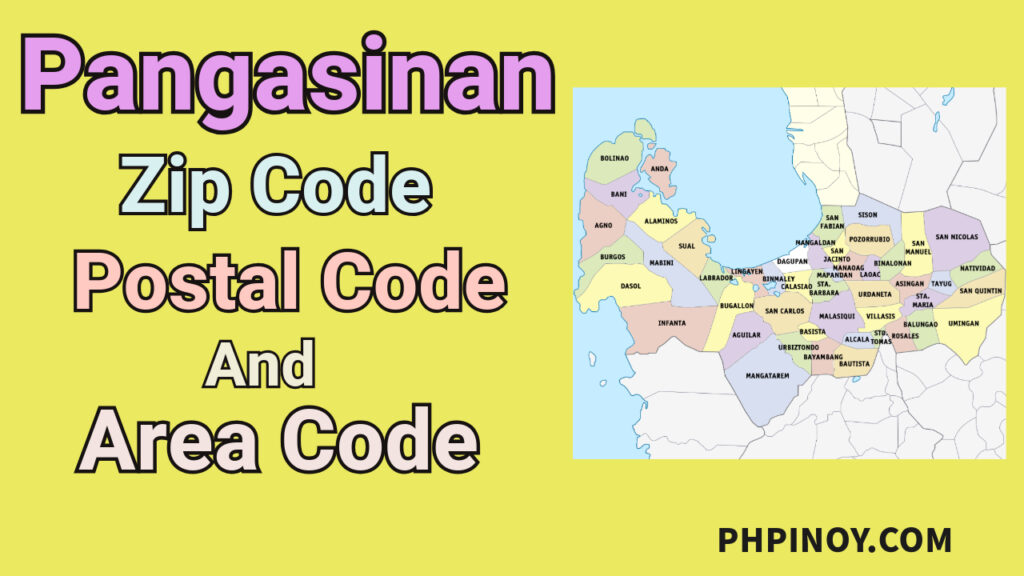Pangasinan is a coastal area situated in the western area of Luzon Island. It has vast fertile lands, making agriculture a major sector of its economy. The province’s name comes from the words Pang-asin-an, which means “place where salt is made.” It is also the country’s salt producer and a major fish supplier. This is also one of the rice granaries in the Philippines, known for producing mango, coconut, and eggplant.
Pangasinan ZIP Codes, Postal Codes, and Area Code
Pangasinan comprises one independent city, 3 component cities, and 44 municipalities. Here are Pangasinan’s postal codes (zip codes) and area codes.
| City/Municipality | Postal Code / Zip Code | Area Code |
| Agno | 2408 | 075 |
| Aguilar | 2415 | 075 |
| Alaminos | 2404 | 075 |
| Alcala | 2425 | 075 |
| Anda | 2405 | 075 |
| Asingan | 2439 | 075 |
| Balungao | 2442 | 075 |
| Bani | 2407 | 075 |
| Basista | 2422 | 075 |
| Bautista | 2424 | 075 |
| Bayambang | 2423 | 075 |
| Binalonan | 2436 | 075 |
| Binmaley | 2417 | 075 |
| Bolinao | 2406 | 075 |
| Bugallon | 2416 | 075 |
| Burgos | 2410 | 075 |
| Calasiao | 2418 | 075 |
| Dagupan City | 2400 | 075 |
| Dasol | 2411 | 075 |
| Infanta | 2412 | 075 |
| Labrador | 2402 | 075 |
| Laoac | 2437 | 075 |
| Lingayen | 2401 | 075 |
| Mabini | 2409 | 075 |
| Malasiqui | 2421 | 075 |
| Manaoag | 2430 | 075 |
| Mangaldan | 2432 | 075 |
| Mangatarem | 2413 | 075 |
| Mapandan | 2429 | 075 |
| Natividad | 2446 | 075 |
| Pozzorubio | 2435 | 075 |
| Rosales | 2441 | 075 |
| San Carlos City | 2420 | 075 |
| San Fabian | 2433 | 075 |
| San Jacinto | 2431 | 075 |
| San Manuel | 2438 | 075 |
| San Nicolas | 2447 | 075 |
| San Quintin | 2444 | 075 |
| Santa Barbara | 2419 | 075 |
| Santa Maria | 2440 | 075 |
| Santo Tomas | 2426 | 075 |
| Sison | 2434 | 075 |
| Sual | 2403 | 075 |
| Tayug | 2445 | 075 |
| Umingan | 2443 | 075 |
| Urbiztondo | 2414 | 075 |
| Urdaneta | 2428 | 075 |
| Villasis | 2427 | 075 |
Key Areas of Pangasinan
Here are some of the key areas of Pangasinan. These places are known for their products, historical landmarks, festivals, tourist attractions, and pilgrimage sites that attract tourists and visitors worldwide.
1. Dagupan City. Known as the Bangus Capital of the Philippines, it is the best place to taste delicious and juiciest bangus (milkfish) raised in a pond. It is also known as the Kitchen of the North for its scrumptious culinary delights. It is also surrounded by sea and rivers and has wonderful festivals, giving tourists many things to do and explore.
2. Alaminos City. The home of the famous Hundred Islands National Park. It is named after Juan Alaminos y Vivar, a Spanish Governor-General of the Philippines. The Galila Hundred Islands festival is the most popular tradition in the city.
3. Lingayen. It is the capital of Pangasinan and is notable for various tourist attractions, such as Lingayen Baywalk, Casa Real, and Sison Auditorium. It is also famous for its bagoong-making industry, so it celebrates the Bagoong Festival.
4. San Carlos City. As the best producer of carabao mangoes and a major trading center for bamboo, it has been called the “bamboo mango capital of the North.” The city also celebrates the Mango-Bamboo Festival.
5. Manaoag. This is a popular pilgrimage site where devotees from different parts of the country visit The Minor Basilica of Our Lady of Holy Rosary of Manaoag. There are also rumors about the “Virgin Mary who calls,” and many people have visited the place since then.
FAQs
What is special about Pangasinan?
Many things are special about Pangasinan, such as beaches, natural attractions, cultures, traditions, and cuisines.
What is Pangasinan also known as?
Pangasinan is also known as “The Salt Capital of the Philippines” and “Land of Miracles and Romance.”
What language is spoken in Pangasinan?
The Pangasinan language is the official language spoken in this province. The other languages are Bolinao, Sambal, Ilocano, Tagalog, and English.
What is the famous thing in Pangasinan
Hundred Islands National Park is one of the famous things in Pangasinan.
